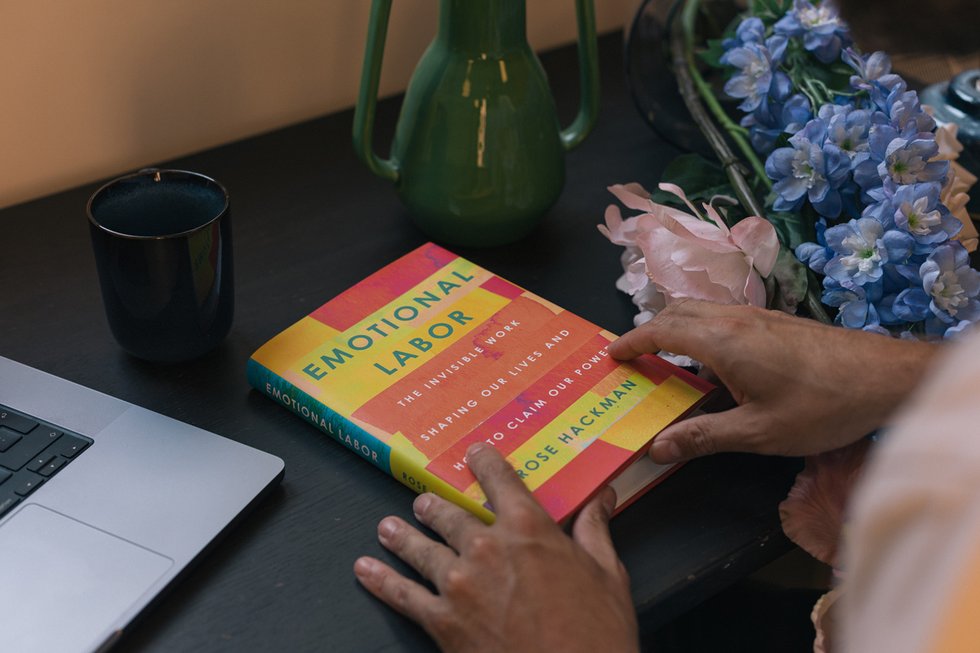Unpacking the burden of emotional labor
08 ago 2024
9 min


US Editor at Welcome to the Jungle
Rose Hackman, a British journalist based in Detroit, has spent the last decade shedding light on pressing social issues through her work in The Guardian. Her insightful reporting on gender, race, labor, policing, housing, and the environment has brought international attention to overlooked American policy issues and historically entrenched injustices.
In her compelling book, Emotional Labor: The Invisible Work Shaping Our Lives and How to Claim Our Power, Hackman delves into the often unseen yet deeply felt work that keeps our personal and professional worlds turning. She uncovers the profound impact of emotional labor—those silent efforts to maintain harmony, manage emotions, and support others—on our daily lives. Her narrative illuminates the invisible load carried primarily by women and minorities, reshaping our understanding of this critical yet undervalued aspect of human interaction.
What is emotional labor and how is it distributed and valued differently among different people and roles?
Emotional labor is the effort someone puts into managing their own emotions to influence the feelings of those around them. It’s the smile someone might offer to a group, even if they’re not feeling great themselves, to lift the group’s spirits. This happens in work settings and private settings. In our society, this kind of work is highly feminized and racialized—women and minorities, in particular, are often expected to do it more. In contrast, others aren’t expected to do it at all.
In professional settings, emotional labor can mean adding smiley faces to emails or always having a smile on your face – even if you do not work in the service or care industry, where emotional labor is central. There’s a double standard for women and minorities. As a woman, for instance, if your expression doesn’t constantly convey peace, happiness, and balance, you’re told you have a “resting bitch face.” When I’m at rest or thinking, I’ve spent 20 years hearing people say I look like I’ve just gone through a tragedy. It’s shocking and baffling that people would comment on your facial expression when it has nothing to do with the job.
We often think of women as facilitators of other people’s experiences, whether in professional or private environments, and also as emotional equilibrium providers. We expect women to constantly reassure us that everything is okay, reflecting a caregiver role. It’s the “mom” at the office who checks in on you and asks about your weekend or the “wife” role that supports the work of a male colleague – even if that has nothing to do with the requirements of her job. These expectations mean women’s time is put to work for the experiences of others and not respected in the same way. Emotional labor is incredibly devalued and often goes unnoticed. We don’t acknowledge it, even if it happens right before our eyes every day, even though it’s one of the most essential forms of work, keeping companies, communities, families, and economies functional.
I’ve spent 20 years hearing people say I look like I’ve just gone through a tragedy. It’s shocking and baffling that people would comment on your facial expression when it has nothing to do with the job.
The emotional labor that is visible and valued in workplaces tends to be performed by male directors or managers. However, we don’t call it labor; we refer to it as emotional intelligence or EQ, which isn’t controversial because it’s been masculinized and celebrated in business schools and research. The issue is that those at the top might do a little and get praised for it, but they don’t have to regulate their emotions or consider their subordinates’ feelings preemptively. At lower professional levels, however, everyone, regardless of gender, has to perform at least some emotional labor.
Fundamentally, emotional labor in the workplace is essential and unavoidable, and that’s not necessarily a bad thing. Workers providing emotional labor for each other makes for a more agreeable and effective workplace. The problem right now is the unequal expectations and the double standards.
How else does emotional labor manifest in the workplace?
Emotional labor can be thought of in the workplace in two broad ways. One type is central to millions of jobs, especially in the service sector. The term was coined by Arlie Hochschild, a brilliant sociologist, in the early 1980s. She aimed to define a form of work at the heart of a booming service sector. In her book, The Managed Heart, she specifically looked at flight attendants. She posited that their job was not just about telling people about security measures and handing out snacks and drinks. Instead, their primary role was to convey positive feelings to passengers, such as feelings of safety, care, and, at that time, sexiness.
Outside of the flight attendant industry, we see emotional labor in healthcare, like a nurse’s bedside manner. In bars and restaurants, servers and bartenders engage in small talk, asking about your day. That’s emotional labor. They might not fundamentally care about your day, but it’s part of their job performance. To earn more than minimum wage, they need to perform this emotional labor to get tips.
To get ahead, men must appear confident and competent. Women seeking to get ahead must also appear confident and competent – but they must also come across as “other-oriented”: be sweet to colleagues, appear caring, and be a team player.
As things stand, hypocrisy is at the heart of emotional labor: We pretend it’s not real or valuable, but when someone stops doing it, we are outraged. For example, if a customer care representative is rude and dismissive, we consider them to be doing a poor job. It’s because society wants to continue extracting it for free or at a discount—even if we all rely on it being done, companies especially.
The second type of emotional labor occurs more in white-collar industries. Culturally, we’re finally starting to have a proper conversation about emotional labor because women entering these previously male-dominated spaces find they need to do additional emotional work to gain acceptance and get a chance at promotions. Even if their job doesn’t explicitly require emotional labor—like a female engineer in a male-dominated field—they often need to make others feel good to be accepted and listened to. This applies to other marginalized groups as well.
This double standard is not fair—but it shows up in organizational psychology studies quite clearly. To get ahead, men must appear confident and competent. Women seeking to get ahead must also appear confident and competent – but they must also come across as “other-oriented”: be sweet to colleagues, appear caring, and be a team player. A female manager might need to have “water cooler” conversations on top of official meetings for her message to land and not be seen as abrasive. In other words, female white-collar workers cannot just focus on their jobs; they must also do emotional labor.
This type of emotional labor perpetuates stereotypes of subordination and the expectation that certain people should constantly cater to others’ feelings. It is deeply ironic – because women who want to survive and thrive in these types of professional environments have little choice but to do emotional labor. It is not a natural expression of themselves but rather a forced one.
So, what impact does this have on the individual?
The first obvious yet powerful point is that it’s a huge time waster. If you have to reread your emails five times because you’ve been told you’re abrasive as a woman, while a male colleague wouldn’t need to, that’s five times the amount of time spent on a task that should have been short and to the point. Social science has clearly shown the impact of stereotypes and how we must navigate them to avoid backlash. In the workplace, backlash can mean being fired or, less severely, not getting any promotion or recognition for work done, which can be frustrating and make a career feel more stagnant than it should.
This can lead to self-doubt and reduced confidence – even if it is caused by social stereotypes rather than any objective productivity metric. In a work environment, this can be detrimental to career progression and the feeling of belonging. In the long term, emotional labor can lead to burnout because you’re forced to perform an inauthentic version of yourself. While I believe everyone should provide some degree of emotional labor in the workplace, we can’t expect some people to do it to such an extent that it alters their sense of self.
The solution isn’t just to stop doing it or ask people to recognize when they require it from others; there needs to be a cultural shift and recognition from HR departments, which must include emotional labor as a promotable skill. Recognizing emotional labor as real work and valuing it appropriately is essential for creating a more equitable work environment.
How can individuals be more mindful about not imposing emotional labor on their colleagues?
For instance, if you return from your weekend and expect your female colleague to listen to your adventures or romantic problems, that’s a significant waste of her time. Similarly, if you ask colleagues for help, advice, or support on a task – you should consider why you expect them to step in. Are you turning to women or minority team members because they seem kinder or more willing to do the emotional legwork you’re avoiding? You might think she’s always willing to listen or help because she’s nice, but she may feel forced.
If more people understood that smiling through an experience is often a defensive act, many wearying and damaging interactions for women could change.
Additionally, suppose you think you’re being flirtatious and someone is smiling through it. In that case, there’s a high probability they do so defensively to avoid upsetting you because they want to keep their job and are afraid of an outburst. Your intentions might not be salacious or aggressive, but you must understand that many people perform emotional labor defensively. This doesn’t mean they enjoy the flirtation or comments; they’re doing it for economic, physical, or social survival.
If more people understood that smiling through an experience is often a defensive act, many wearying and damaging interactions for women could change. This form of coercive emotional labor is something women are forced into, not because they enjoy it, but because they’ve been trained to do so through painful experience and practice.
What advice would you give to people facing these double standards?
I’m very reluctant, but I think it’s important to address this. Over a decade ago, when Sheryl Sandberg released Lean In, part of her message was crucial. However, it mostly offered individual solutions to systemic problems. We must be careful not to suggest that individuals are responsible for structural sexism and racism in the workplace.
Workplaces are evolving, but not as quickly as many would like. It’s a balancing act to figure out how to exist, evolve, and ideally thrive in these environments. Understanding double standards and the rules of the game can help you navigate this, even if it seems messed up.
I am fighting for cultural and systemic change. The more people understand emotional labor as a real form of work and how stereotypes force marginalized workers to be other-oriented and self-effacing, the more we can call out these double standards. While I can’t offer a simple solution for changing a sexist or racist boss, we need to advocate for changes in HR and management.
How could HR and management change their approach to turn emotional labor into promotable work and better recognize its value?
Research shows that emotional labor measurably helps companies succeed. Studies have long concentrated on EQ as a significant measure of leadership success. However, emotional labor is also a huge measure of team success, regardless of rank. HR departments can view emotional labor as a valuable addition to the company in two ways.
First, it creates value in terms of productivity. Emotional labor often goes hand in hand with other forms of work—intellectual and physical. Being a team player is often necessary to complete larger intellectual tasks; navigating pressure and various demands with regulated emotionalityand a view of the bigger picture is often crucial to meeting a deadline.
Second, emotional labor builds brands. Over the past year, I’ve talked to many teachers and professors who feel seen by the concept of emotional labor. For them, most of their work is emotional labor, not intellectual labor. Teachers and professors, not administrators, build the brand of educational institutions. Similarly, in a buzzing restaurant or bar, it is often the friendly servers, together with the quality of the menu, that keep customers coming back time after time.
You have to understand the double standards of emotional labor. Know that it’s not your fault, but also recognize its value.
I’ve been astonished at how much success in various workplaces depends on building relationships with people. Even though my work as a journalist and writer involves digesting academic research, interviewing people, the one explicit aspect of the job that is emotional labor, and writing about it, my sustained success comes from the relationships I’ve built and my ability to navigate them.
You have to understand the double standards of emotional labor. Know that it’s not your fault, but also recognize its value. This might seem like a lot. But the more people understand, see, and value it, the closer we get to change. In the meantime, as we wait for the needed systemic change, you can hone the skills to understand emotional labor, seeing it as a finite form of work that requires time, effort, and skill. Once you do that, you can choose when it is useful for you to do it and when you would prefer not to.
Photo: Welcome to the Jungle
Follow Welcome to the Jungle on Facebook, LinkedIn, and Instagram and subscribe to our newsletter to get our latest articles every week!

Más inspiración: Salud mental en el trabajo

‘We need each other’: Monika Jiang on combating loneliness in hybrid work
Hybrid work offers flexibility but can leave us feeling disconnected. Monika Jiang explores how we can rebuild workplace connections.
19 dic 2024

Struggling at work? Here are 3 steps to rebuilding your self-esteem
Low on confidence? Learn how reflection, recharging, and refocusing can help you rebuild self-esteem and thrive professionally.
27 nov 2024

10 ways to beat the Sunday Scaries
Even people who love their jobs can experience the Sunday Scaries. Psychologist Karen Doll offers several strategies to help manage and overcome it.
12 sept 2024

Is financial anxiety harming your productivity?
Feeling overwhelmed by financial anxiety? You're not alone. Discover practical steps and expert advice to regain control of your work-life balance.
31 jul 2024

How to beat the post-PTO blues
Feeling down after a vacation is normal, but planning ahead and getting back into your routine can help beat those post-trip blues.
29 jul 2024

¿Estás buscando tu próxima oportunidad laboral?
Más de 200.000 candidatos han encontrado trabajo en Welcome to the Jungle
Explorar ofertas